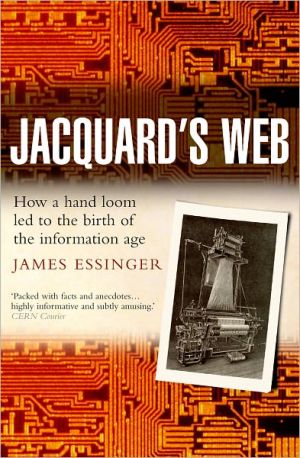Jacquard's Web: How a Hand-Loom Led to the Birth of the Information Age
Circuits from silk? Today's technophiles probably have no idea how much today's computer technology owes to the invention of one ingenuous textile manufacturer in nineteenth-century France. Here, master storyteller James Essinger shows through a series of remarkable and meticulously researched historical connections how the Jacquard loom kick-started a process of scientific evolution which would lead directly to the development of the modern computer.\ Jacquard's 1804 invention, a loom which...
Search in google:
In Jacquard's Web, James Essinger tells the story of some of the most brilliant inventors the world has ever known, in this fascinating account of how a hand-loom invented in Napoleonic France led to the development of the modern information age. Essinger, a master story-teller, describes how Joseph-Marie Jacquard's loom enabled the silk-weavers of Lyons to weave fabrics 25 times faster than had previously been possible. The device used punched cards, which stored instructions for weaving whatever pattern or design was required. These cards can very reasonably be described as the world's first computer programs. Indeed, Essinger shows through a series of remarkable and meticulously researched historical connections--connections never before investigated--that the Jacquard loom kick-started a process of scientific evolution which would lead directly to the development of the modern computer. The book examines a wealth of extraordinary links between the nineteenth-century world of weaving and today's computer age: for example, modern computer graphics displays are based on exactly the same principles as those employed in Jacquard's special woven tableaux. Jacquard's Web also introduces some of the most colorful and interesting characters in the history of science and technology: the modest but exceptionally dedicated Jacquard himself; the brilliant but temperamental Victorian polymath Charles Babbage, who dreamed of a cogwheel computer operated using Jacquard cards; and the imaginative and perceptive Ada Lovelace, Lord Byron's only legitimate daughter. Attractively illustrated and compellingly narrated, Jacquard's Web is an engaging and delightful volume. It is an impressive case of historical detective work, one that will leave the reader mesmerized.Kirkus ReviewsA British science writer traces the history of the punched card, from the Jacquard loom, which programmed the weaving of elaborate silk brocades, to the modern computer. After a brief history of silk, Essinger introduces Joseph-Marie Jacquard (1752-1834), the son of a master-weaver. In Napoleonic France, after the revolution, Jacquard puttered aimlessly until about 1800, when he patented an improved loom. In its final form, the Jacquard loom wove the complex patterns that made it famously 24 times faster than earlier versions, but with half the manpower. Honored by Napoleon, Jacquard lived out his life in prosperity; but the story of his cards had just begun. In England, Charles Babbage (1792-1871) conceived a machine to calculate the mathematical tables that Victorian science and industry were increasingly coming to rely on. In 1834 he decided to use Jacquard's cards to control his machine. With the help of Lord Byron's daughter Ada, Countess Lovelace (1816-52), he worked on the design for several years, but the lack of sufficiently precise and uniform mechanical parts prevented him from completing his Analytical Engine. The next step in the career of Jacquard's cards came when the American engineer Herman Hollerith (1860-1929) built a machine to tabulate the data from the 1890 US Census. In 1911, Hollerith's tabulating machine company merged with two others to form IBM. Those IBM cards (as they were now known) programmed the pioneering computer designed by Howard Aiken and built by IBM in 1944, and the electronic machines-ENIAC, UNIVAC, and their successors-that made computing practical. The IBM card dominated computing until the 1980s, when electronic devices took over its function,and played a role in history as late as the election of 2000. Essinger's sketches of the various inventors and scientists are lively, and he effectively places their contributions in historical context. Fascinating scientific history based on the humblest of artifacts. Agent: Sheila Ableman
1The engraving that wasn't12A better mousetrap73The son of a master-weaver194The emperor's new clothes275From weaving to computing456The difference engine657The analytical engine818A question of faith and funding999The lady who loved the Jacquard loom11910A crisis with the American census14911The first Jacquard looms that wove information15912The birth of IBM17913The Thomas Watson phenomenon19514Howard Aiken dreams of a computer19515IBM and the Harvard Mark I21916Weaving at the speed of light23917The future253App. 1Charles Babbage's vindication265App. 2Ada Lovelace's letter to Charles Babbage, 14 August 1843270App. 3How the Jacquard loom worked277
\ From the Publisher"With wit and imagination, Essinger has woven a marvelous tapestry celebrating this rugs-to-riches story and the unlikely birth of the information age."--Entertainment Weekly\ "Jacquard's Web is more than the biography of a man and his machine. Mr. Essinger moves from the Industrial Age to the Information Age, connecting the loom, step by step, to the Harvard Mark I, the first proper computer, presented to the public in 1944.... Essinger tells his story with passion and with a gracious willingness to help the lay reader grasp the intricacies of technology."--Wall Street Journal\ "Essinger does more than weave together science, history, and business: he sheds light on the nature of innovation.... His book deftly shows how even the most surprising breakthroughs are based on the work of others, and need a host of enabling factors to take root. Without the appropriate financial, technological, and cultural factors, no inventor, regardless of passion, can harvest his brilliant machine.... His tale of cultural, economic, and personal factors that enable ideas to become real tools makes this book a welcome addition to the literature of innovation."-- Tom Ehrenfeld, The Boston Globe\ "Anyone who enjoyed Tom Standage's book on automata, The Mechanical Turk, will probably enjoy Jacquard's Web."--New Scientist\ "An original perspective...the thread that runs through it--the relation of everything that has come since to the principle of the Jacquard loom--quite compelling."--Walter Gratzer, King's College London\ \ \ \ \ \ Kirkus ReviewsA British science writer traces the history of the punched card, from the Jacquard loom, which programmed the weaving of elaborate silk brocades, to the modern computer. After a brief history of silk, Essinger introduces Joseph-Marie Jacquard (1752-1834), the son of a master-weaver. In Napoleonic France, after the revolution, Jacquard puttered aimlessly until about 1800, when he patented an improved loom. In its final form, the Jacquard loom wove the complex patterns that made it famously 24 times faster than earlier versions, but with half the manpower. Honored by Napoleon, Jacquard lived out his life in prosperity; but the story of his cards had just begun. In England, Charles Babbage (1792-1871) conceived a machine to calculate the mathematical tables that Victorian science and industry were increasingly coming to rely on. In 1834 he decided to use Jacquard's cards to control his machine. With the help of Lord Byron's daughter Ada, Countess Lovelace (1816-52), he worked on the design for several years, but the lack of sufficiently precise and uniform mechanical parts prevented him from completing his Analytical Engine. The next step in the career of Jacquard's cards came when the American engineer Herman Hollerith (1860-1929) built a machine to tabulate the data from the 1890 US Census. In 1911, Hollerith's tabulating machine company merged with two others to form IBM. Those IBM cards (as they were now known) programmed the pioneering computer designed by Howard Aiken and built by IBM in 1944, and the electronic machines-ENIAC, UNIVAC, and their successors-that made computing practical. The IBM card dominated computing until the 1980s, when electronic devices took over its function,and played a role in history as late as the election of 2000. Essinger's sketches of the various inventors and scientists are lively, and he effectively places their contributions in historical context. Fascinating scientific history based on the humblest of artifacts. Agent: Sheila Ableman\ \








